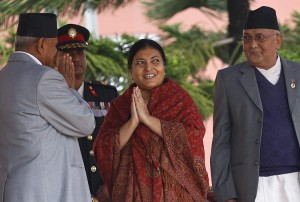Nepal’s Madame President
Thursday, October 29th, 2015October 29, 2015

On October 29, Nepal’s first woman president, Bidhya Bhandari, is congratulated by outgoing President Ram Baran Yadav (left), while Prime Minister K.P. Oli (right) looks on. Bhandari had just taken the oath of office in a ceremony in Kathmandu, Nepal. (Credit: © Narendra Shrestha, EPA/Landov)
Nepal’s parliament made history on Wednesday when it elected Bidhya Devi Bhandari as the Himalayan country’s first woman president. Bhandari is a women’s rights campaigner who helped ensure representation for women in the government under a constitution passed in September 2015. The new constitution mandates that either the president or the vice-president must be a woman, and that one-third of the seats in parliament are reserved for women. Under Nepal’s constitution, the role of president is largely ceremonial; a prime minister heads the government.
Bhandari is Nepal’s second elected president since the country abolished its monarchy in 2008. The country’s transition to democracy was neither easy nor quick. The process began in 2008 after voters elected a Constituent Assembly to write a new constitution. The assembly could not agree on the constitution’s contents, however, and the group was abolished in 2012. The process began anew in 2013, but it took until September 2015 for the second assembly to finally agree on a constitution. Aside from ensuring representation for women in Nepal’s government, the new constitution also created a bicameral (two-house) legislature and divided the country into seven provinces. Tensions remained, however, as some minority groups expressed concern that they would be underrepresented in the new government.


